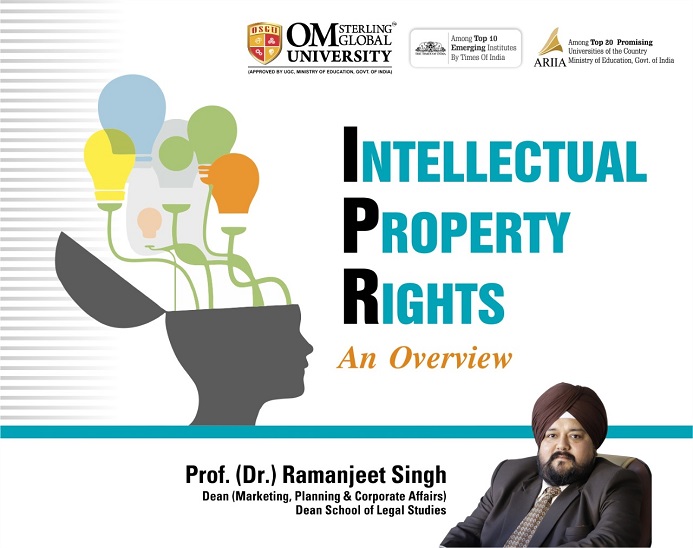-
Announcement : Admission Open Apply Now
 Pratibha Samman Samaroh– 2024
Pratibha Samman Samaroh– 2024 
Intellectual Property Rights – An Overview

Euphoria’ – The fresher’s welcome event organized at Om sterling Global University 24th Dec 2021 for 1st & 2nd-year students.
December 28, 2021
Moot Court Competition Result (First Day)
January 28, 2022
Intellectual Property Rights
INTRODUCTION
In India, there is a profusion of creative and innovativeenergies Creative and innovation are the key driver’s contributing to the growth and development of anyknowledge economy. There is an imperative need to protect these inventions and creative works of individuals and firms.For this Intellectual property (IP) plays an important role and backs immensely to our national and state economies Basically, Intellectual Property Rights provide a legalprotection to those who invent or creates It. The legal rights confer an exclusive right to the inventor or creator of theIntellectual property rights to utilize his creation for a specific period of time. In the context of globalization, the innovation and creativeness assume greater significance to compete the stiff competitions. Policy framework for intellectual property rights is necessary as the development of the economy somewheredepends on it which provides the legal protection to the new discoveries and inventions. In India, we have well established legislative framework for safeguarding the IPRs. The TRIPs (Trade Related Intellectual Property) regime has emerged as the basic framework tor ensuring intellectual property rights across the world. It is not the universal Intellectual property law. But it provides a basic framework. Every member of WIO should include TRIPS provisions in their domestic intellectual property legislations. Different amendments to the various existing Acts- Patent Amendment Act (2005), Copy right Amendment Act (2010), are made to strengthen domestic legal Framework tofulfill the harmonization with the WTO’s TRIPS agreement.’ Similarly, a number of fresh legislations are made to upgrade the country’s intellectual property regime. India has recently joined three WIPO treaties designed to ease the search for trademarks and Industrial designs, helping brand owners and designers in their efforts to obtain protection for their own work.
Key Advantages of Securing the Intellectual Property Rights
- To secure the innovation
IP provides protection, recognition and royalty to unique ideas and new creation. Henceforth, it is decisive to protect the IP assets before they are illegally infringed by any third party.
- Accelerates the Business Growth
For small companies, losing a market share in the initial stage in a business can be hazardous to its business health in the long term. It is very vital from them to armour their exclusive products or services, which can be used by the opponents for taking away the market share.
- Unique identity
Intellectual Property Rights helps to distinguish the products of the one company to another and creates unique identity for the business.
- Generates revenues
Registering the intellectual property rights generates revenues and profits by turning your ideas in to commercially successful products which can improve the overall business growth.
Comparison of IPR Revenue
The total revenue generated was Rs. 86242.97 lakh, which is about 12.1 % higher than that of the previous year, The total revenue generated by the Patent and Design Office was Rs. 52123.8 (Patents Rs. 51518.03 & Designs Rs. 605.77 lakh), whereas the Trade Marks Registry generated a revenue of Rs. 34119.17 lakh.
Comparison of IPR Revenue Generation last five years
| Year | Patents | Design | Trademark | Total (Rs.In lakh) |
| 2014-15 | 37400.71 | 231.50 | 13813 | 51445.21 |
| 2015-16 | 39840.40 | 557.72 | 18316.01 | 58714.13 |
| 2016-17 | 41003.18 | 551.44 | 19236.89 | 60791.51 |
| 2017-18 | 47706.62 | 615.92 | 28611.35 | 76933.89 |
| 2018-19 | 51518.03 | 605.77 | 34119.17 | 86242.97 |
National Intellectual Property Rights (IPR) Policy
The Union Cabinet has approved the National Intellectual Property Rights (IPR) Policy on 12th may, 2016 that shall lay the future roadmap for IPRs in India. A nation-wide policy has been launched with an aim to improve the awareness about the benefits of IPRs and their value to the rights-holders and the public. The scheme of IPR awareness, Creative India, Innovative India was launched from April 1, 2017 for duration of 3 Years by the Department of Industrial Policy and Promotion, Ministry of Commerce and Industry. Salient feature of this Scheme is to conduct IP awareness programmes. The programmes include conducting workshops/seminars in collaboration with industry organizations, academic institutions and other stakeholders across the country, training programmes to create a resource pool of trainers who would conduct the IP Awareness workshops/seminars for the public, enforcement agencies and judiciary, awareness of ill effects of piracy and counterfeiting etc. in continuation with the goal of creating awareness on Intellectual Property and Innovation Management, R&D Institutions and Universities, 32 programmes have been successfully conducted with industry associations in the year 2018-2019. Now, DIPP is the nodal point to coordinate, guide and oversee implementation and future development of IPRs in India, the responsibility for actual implementation of the plans of action will remain with the Ministries/ Departments concerned in their assigned sphere of work.
These Awareness programmes propelled by the Government of India and issuance of Guidelines on the examination of computer related inventions significantly improved the patentability environment to achieve more technological innovations and the Global Innovative Index Report of Sixth edition stands testimony for this. As per the Global Innovation Index 2020, China, Vietnam, India and the Philippines are the economies that have achieved significant progress in their GII innovation ranking over time. All four are now in the top 50 among the lower middle income group; India now ranks 3rd among economy group, a new milestone.
Conclusion
Intellectual Property Rights are the monopoly rights that provide the holders privilege of the exclusive right on their inventions. In this digitized and knowledge driven era, it is more important that IP holders are expected to know the benefits arising out the Intellectual Property rights. Indeed, National IPR Policy replicates the extent to which government engage in educational campaigns promoting IPR awareness which is noteworthy. India continuously examined the accession to some multilateral treaties which are in India’s interest and engage itself constructively in the negotiation of international treaties and agreements. It is crucial to develop IPR policy and law, strategy, administration and its enforcement policy in order to harness the full potential of IPRs for economic growth.



